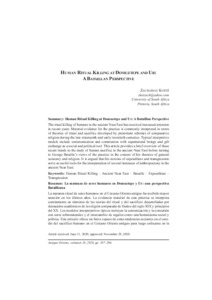Please use this identifier to cite or link to this item:
https://repositorio.uca.edu.ar/handle/123456789/11721| Título: | Human ritual killing at Domuztepe and Ur : a bataillan perspective La matanza de seres humanos en Domuztepe y Ur : una perspectiva Batailleana |
Autor: | Kotzé, Zazharias | Palabras clave: | CERCANO ORIENTE; ANTIGUO ORIENTE; RITUALES; SACRIFICIO; Bataille, Georges, 1897-1962 | Fecha de publicación: | 2020 | Editorial: | Pontificia Universidad Católica Argentina. Facultad de Ciencias Sociales. Departamento de Historia. Centro de Estudios de Historia del Antiguo Oriente | Cita: | Kotzé, Z. Human ritual killing at Domuztepe and Ur : a bataillan perspective [en línea]. Antiguo Oriente. 2020, 18 Disponible en: https://repositorio.uca.edu.ar/handle/123456789/11721 | Resumen: | Abstract: The ritual killing of humans in the ancient Near East has received increased attention
in recent years. Material evidence for the practice is commonly interpreted in terms
of theories of ritual and sacrifice developed by prominent scholars of comparative
religion during the late nineteenth and early twentieth centuries. Typical interpretive
models include communication and communion with supernatural beings and gift
exchange as a social and political tool. This article provides a brief overview of these
recent trends in the study of human sacrifice in the ancient Near East before turning
to George Bataille’s views of the practice in the context of his theories of general
economy and religion. It is argued that his notions of expenditure and transgression
serve as useful tools for the interpretation of several instances of anthropoctony in the
ancient Near East. Resumen: La matanza ritual de seres humanos en el Cercano Oriente antiguo ha recibido mayor atención en los últimos años. La evidencia material de esta práctica se interpreta comúnmente en términos de las teorías del ritual y del sacrificio desarrolladas por destacados académicos de la religión comparada de finales del siglo XIX y principios del XX. Los modelos interpretativos típicos incluyen la comunicación y la comunión con seres sobrenaturales y el intercambio de regalos como una herramienta social y política. Este artículo ofrece un breve repaso de estas tendencias recientes en el estudio del sacrificio humano en el Cercano Oriente antiguo para luego enfocarse en la perspectiva de George Bataille sobre esta práctica en el contexto de sus teorías sobre la economía general y la religión. Asimismo, se argumenta aquí que sus nociones de gasto y transgresión sirven como herramientas útiles para la interpretación de varios casos de antropoctonía en el Cercano Oriente antiguo. |
URI: | https://repositorio.uca.edu.ar/handle/123456789/11721 | ISSN: | 1667-9202 | Disciplina: | HISTORIA | Derechos: | Acceso abierto | Fuente: | Antiguo Oriente. 2020, 18 |
| Appears in Collections: | AO - 2020 vol. 18 |
Files in This Item:
| File | Description | Size | Format | |
|---|---|---|---|---|
| human-ritual-killing-domuztepe.pdf | 103,32 kB | Adobe PDF |  View/Open |
Page view(s)
131
checked on Apr 30, 2024
Download(s)
396
checked on Apr 30, 2024
Google ScholarTM
Check
This item is licensed under a Creative Commons License

